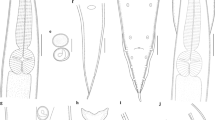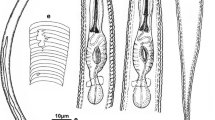Abstract
Specimens of Contracaecum rudolphii sensu lato (s.l.) (Nematoda: Anisakidae) from Phalacrocorax carbo sinensis from northeastern and central Italy were characterised genetically and compared with those from Phalacrocorax aristotelis from Galician coasts, Spain (identified as C. rudolphii A by multilocus enzyme electrophoresis) and with specimens of C. septentrionale from Alca torda from the Galician coasts, Spain. The first (ITS-1) and second (ITS-2) internal transcribed spacers (ITS) of ribosomal DNA (rDNA) were amplified by polymerase chain reaction (PCR) from individual nematodes and the amplicons subjected to single-strand conformation polymorphism (SSCP) analysis and/or sequencing. For each ITS region, C. septentrionale specimens were distinct from those of C. rudolphii (s.l.) and C. rudolphii A based on SSCP profiles and ITS sequences. Some specimens of C. rudolphii (s.l.) had the same SSCP profiles and ITS sequences as C. rudolphii A, whereas the others had distinct SSCP profiles and ITS sequences and were suggested to represent C. rudolphii B based on host and geographical origins and genetic similarity to C. rudolphii A. While no length or nucleotide variation in the ITS-1 and ITS-2 sequences was detected within each taxon, nucleotide differences of 1.8–5.5% (ITS-1) and 5.1–12.2% (ITS-2) were detected among them. The results support the hypothesis that C. rudolphii represents a complex of at least two sibling species and provide support for the validity of C. septentrionale as a separate species. The definition of genetic markers in the ITS rDNA provides opportunities for investigating the life cycles, transmission patterns and ecology of the anisakid nematodes studied herein.


Similar content being viewed by others
References
Abollo E, Gestal C, Pascual S (2001) Anisakid infection in the European shag Phalacrocorax aristotelis aristotelis. J Helminthol 75:209–214
Adams AM, Murrell KD, Cross JH (1997) Parasites of fish and risks to public health. Rev Sci Tech Off Int Epizoot 16:652–660
Barson M, Marshall BE (2004) First record of Contracaecum spp. (Nematoda:Anisakidae) in fish-eating birds from Zimbabwe. J S Afr Vet Assoc 75:74–78
Barus V, Sergeeva TP, Sonin MD, Ryzhikov KM (1978) Helminths of fish-eating birds of the Palaeartic region. I. Nematoda. Academia, Prague
Barus V, Tenora F, Kracmar S, Prokes M (2001) Cadmium and lead concentrations in Contracaecum rudolphii (Nematoda) and its host, the cormorant Phalacrocorax carbo (Aves). Folia Parasitol 48:77–78
Chilton NB, Gasser RB, Beveridge I (1995) Differences in a ribosomal DNA sequence of morphologically indistinguishable species within the Hypodontus macropi complex (Nematoda: Strongyloidea). Int J Parasitol 25:647–651
Cianchi R, Orecchia P, Berland B, Paggi L, D’Amelio S, Mattiucci S, Nascetti G, Bullini L (1992) Genetic studies on some Contracaecum species, parasites of fish-eating birds. In: Abstracts, VIth European multicolloquium of parasitology, The Hague, The Netherlands, p 127
D’Amelio S, Nascetti G, Mattiucci S, Cianchi R, Orecchia P, Paggi L, Berland B, Bullini L (1990) Ricerche electroforetiche su alcune specie del genere Contracaecum, parassiti di uccelli ittiofagi (Ascaridida: Anisakidae). Parassitologia 32(Suppl 1):77
Dezfuli BS, Volponi S, Beltrami I, Poulin R (2002) Intra- and interspecific density-dependent effects on growth in helminth parasites of the cormorant, Phalacrocorax carbo sinensis. Parasitology 124:537–544
Gasser RB, Chilton NB, Hoste H, Beveridge I (1993) Rapid sequencing of rDNA from single worms and eggs of parasitic helminths. Nucleic Acids Res 21:2525–2526
Hartwich G (1964) Revision der vogelparasitischen Nematoden Mitteleuropas II.—Die Gattung Contracaecum Railliet and Henry, 1912 (Ascaridoidea). Mitt Zool Mus Berl 40:15–53
Huizinga HW (1966) Studies on the life cycle and development of Contracaecum spiculigerum (Rudolphii, 1809) (Ascaroidea: Heterocheilidae) from marine piscivorous birds. J Elisha Mitchell Scient Soc 82:181–195
Jacobs DE, Zhu XQ, Gasser RB, Chilton NB (1997) PCR-based methods for identification of potentially zoonotic ascaridoid parasites of the dog, fox and cat. Acta Trop 68:191–200
Kijewska A, Rokicki J, Sitko J, Węgrzyn G (2002) Ascaridoidea: a simple DNA assay for identification of 11 species infecting marine and freshwater fish, mammals and fish-eating birds. Exp Parasitol 101:35–39
Ko RC (1995) Fish-borne parasitic zoonoses. In: Woo PTK (ed) Fish diseases and disorders, vol I. Protozoan and metazoan infections. CAB International, Wallingford, pp 631–671
Kreis HA (1955) Contracaecum septentrionale, ein neuer parasit aus dem Kormoran; sein Lebenslauf, sowie Angaben über die Entwicklung der Anisakinae. Z Parasitkde 17:106–121
Mattiucci S, Turchetto M, Bragantini F, Nascetti G (2002) On the occurrence of the sibling species of Contracaecum rudolphii complex (Nematoda: Anisakidae) in cormorants (Phalacrocorax carbo sinensis) from Venice and Caorle lagoons: genetic markers and ecological studies. Parassitologia 44(Suppl 1):105
McCarthy J, Moore TA (2000) Emerging helminth zoonoses. Int J Parasitol 30:1351–1360
Paggi L, D’Amelio S, Ortis M, Mattiucci S, Mariniello L, Di Cave D, Orecchia P (1998) Metazoi parassiti di pesci di valore economico delle lagune costiere del Parco Nazionale del Circeo. Biol Mar Medit 5:1593–1599
Szostakowska B, Myjak P, Kur J (2002) Identification of anisakid nematodes from the Southern Baltic Sea using PCR-based methods. Mol Cell Probes 16:111–118
Takahashi S (1998) Anisakidosis: global point of view. In: Ishikura H, Aikawa M, Itakura H, Kikuchi K (eds) Host response to international parasitic zoonoses. Springer, Tokyo, pp 109–120
Torres P, Ruiz E, Gesche W, Montefusco A (1991) Gastrointestinal helminthes of fish-eating birds from Chiloe Island, Chile. J Wildl Dis 27:178–179
Torres P, Valdivieso J, Schlatter R, Montefusco A, Revenga J, Marín F, Lamilla J, Ramallo G (2000) Infection by Contracaecum rudolphii (Nematoda: Anisakidae) in the Neotropic cormorant Phalacrocorax brasilianus, and fishes from the estuary of the Valdivia river, Chile. Stud Neotrop Fauna Environ 35:101–108
Yang TB, Liao XH (1997) The identification of Ligula intestinalis and Contracaecum rudolphii parasitizing in the body cavity of Gymnocypris przewalskii przewalskii (in Chinese with abstract in English). Acta Sci Nat Univ Sun- Yatseni 36:127–128
Yang TB, Liao XH, Zeng BP (2000) Population ecology of Contracaecum rudolphii in the host Gymnocypris przewalskii przewalskii in the Qinghai Lake (in Chinese with abstract in English). Acta Hydrobiol Sinica 24:213–218
Yang TB, Miao SY, Liao XH, Wang ZJ (2001) Studies on the dynamic mechanism of cavity helminthes in Gymnocypris przewalskii przewalskii in the Qinghai Lake: ecological approach and their relationship to feeding of host (in Chinese with abstract in English). Acta Hydrobiol Sinica 25:268–273
Zhu XQ, Gasser RB (1998) Single-strand conformation polymorphism (SSCP)-based mutation scanning approaches to fingerprint sequence variation in ribosomal DNA of ascaridoid nematodes. Electrophoresis 19:1366–1373
Zhu XQ, Jacobs DE, Chilton NB, Sani RA, Cheng NABY, Gasser RB (1998a) Molecular characterization of a Toxocara variant from cats in Kuala Lumpur, Malaysia. Parasitology 117:155–164
Zhu XQ, Gasser RB, Podolska M, Chilton NB (1998b) Characterisation of anisakid nematodes with zoonotic potential by nuclear ribosomal DNA sequences. Int J Parasitol 28:1911–1921
Zhu XQ, Chilton NB, Jacobs DE, Boes J, Gasser RB (1999) Characterisation of Ascaris from human and pig hosts by nuclear ribosomal DNA sequences. Int J Parasitol 29:469–478
Zhu XQ, D’Amelio S, Paggi L, Gasser RB (2000a) Assessing sequence variation in the internal transcribed spacers of ribosomal DNA within and among members of the Contracaecum osculatum complex (Nematoda: Ascaridoidea: Anisakidae). Parasitol Res 86:677–683
Zhu XQ, Gasser RB, Jacobs DE, Hung GC, Chilton NB (2000b) Relationships among some ascaridoid nematodes based on ribosomal DNA sequence data. Parasitol Res 86:738–744
Zhu XQ, D’Amelio S, Hu M, Paggi L, Gasser RB (2001) Electrophoretic detection of population variation within Contracaecum ogmorhini (Nematoda: Ascaridoidea: Anisakidae). Electrophoresis 22:1930–1934
Zhu XQ, D’Amelio S, Palm HW, Paggi L, George-Nascimento M, Gasser RB (2002) SSCP-based identification of members within the Pseudoterranova decipiens complex (Nematoda: Ascaridoidea: Anisakidae) using genetic markers in the internal transcribed spacers of ribosomal DNA. Parasitology 124:615–623
Acknowledgements
Project support was provided in part by the China National Funds for Distinguished Young Scientist (Grant No. 30225033), the Natural Science Foundation of Guangdong Province (Grant No. 36835) and the Scientific and Technological Programmes of Guangdong Province (Grant No. 2004B50201020) to XQZ, as well as the Natural Science Foundation of Guangdong Province (No. 036606) to ZRL.
Author information
Authors and Affiliations
Corresponding author
Additional information
Declaration: The experiments comply with the current laws of the countries in which the experiments were performed.
Rights and permissions
About this article
Cite this article
Li, AX., D’Amelio, S., Paggi, L. et al. Genetic evidence for the existence of sibling species within Contracaecum rudolphii (Hartwich, 1964) and the validity of Contracaecum septentrionale (Kreis, 1955) (Nematoda: Anisakidae). Parasitol Res 96, 361–366 (2005). https://doi.org/10.1007/s00436-005-1366-y
Received:
Accepted:
Published:
Issue Date:
DOI: https://doi.org/10.1007/s00436-005-1366-y




